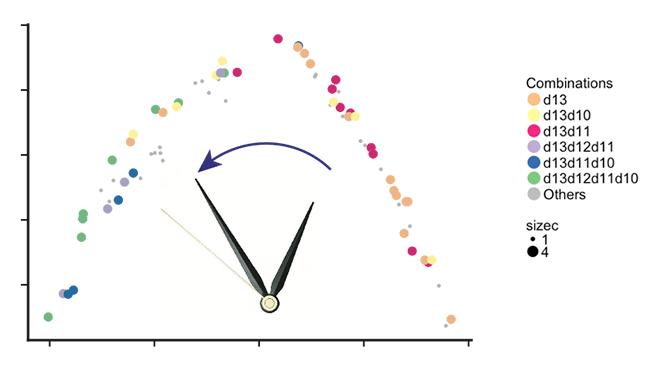The gene code of growing limbs

Growing hand with HoxD combinatorial code (credit: P. Fabre and Q. Lo Giudice, University of Geneva)
Scientists from EPFL and the University of Geneva have discovered a “code” of architect genes that are expressed in specific combinations during the development of hands and fingers. The study decrypts developmental gene expression at the level of the single cell in developing limbs and expands our understanding of the genetics behind growing limbs.
When a fetus develops, everything must be timed to perfection: cell division and differentiation, gene expression, cell-to-cell signaling, and morphogenesis must be carefully coordinated to occur in the correct sequence and for the proper amount of time. Failures in timing can result in congenital deformities, disabilities, and even death.
The big question that developmental biologists have been asking for a long time is this: what sets the pace and the order of developmental events?
Looking at the development of the paw and digits in mice, scientists from the lab of Denis Duboule at EPFL, with Pierre Fabre at the University of Geneva, have now discovered a “code” of architect genes that play a central role in the developmental cascade. The genes belong to the Hoxd group, developmental genes that are active in various combinations inside so-called “progenitor” cells – cells that are just a step more specialized than stem cells.
By pushing a cutting-edge single-cell RNA sequencing technique to its maximal resolution, the scientists were able to study the expression patterns of thousands of genes inside single progenitor cells. The analysis showed that each cell contains 343 genes that are associated with specific cellular states, many of which are involved in the packaging and ordering of DNA in the cell, as well as patterning how the paw’s fingers will develop.
The scientists identified a very restricted set of six main combinations of five Hoxd genes (Hoxd9, 10, 11, 12, and 13) in the development of digits in mice. Each combination includes one, two, or four of the genes, with the simplest (one gene) at the beginning of development and the more complex (four genes) combination occurring at the later stages of maturation.
The pattern by which Hox genes are expressed when they “build” the entire body – in both mice and humans – has been known and studied for over thirty years. But most of that information comes from looking at entire tissues of developing organs. In contrast, this study is the first to look at it in single cells, offering a higher resolution and clarity in the way Hox genes orchestrate the rhythm of development.

A graph showing the five combinations of Hoxd genes in precursor cells during development of the paw and digits of mice. Each dot represents a single cell; each color represents one of the Hoxd combinations, which match different degrees of differentiation (earliest stages on the left). The graphic highlights the switch between cellular temporal states involved in a regulatory network. The cells with only one gene are in a more premature state while the one expressing a higher set of these genes being at the end of their maturation. Credit: Pierre J. Fabre and Quentin Lo Giudice, University of Geneva.
“The study shows how architect genes act in concert, following a gradual progression in every developing cell to generate our fully mature arms and hands at the right time and the right place,” says Pierre Fabre. “The Hoxd gene combinations provide a machinery that generate a spectrum of functionally different cells within genetically-defined classes of limb patterning motifs. This will pave the way for future genetic work to understand how cells get to synchronize the combined activation of multiple genes.”
This study is a collaboration between the faculties of Science and Medicine of the University of Geneva with EPFL’s ISREC Foundation and BBCF.
EPFL
University of Geneva
Swiss National Science Foundation (Ambizione)
European Research Council (SystemHox and RegulHox)
Pierre J Fabre, Marion Leleu, Benedicte Mascrez, Quentin Lo Giudice, John Cobb, Denis Duboule. Heterogeneous combinatorial expression of Hoxd genes in single cells during limb development. BMC Biology 18 September 2018. DOI: 10.1186/s12915-018-0570-z